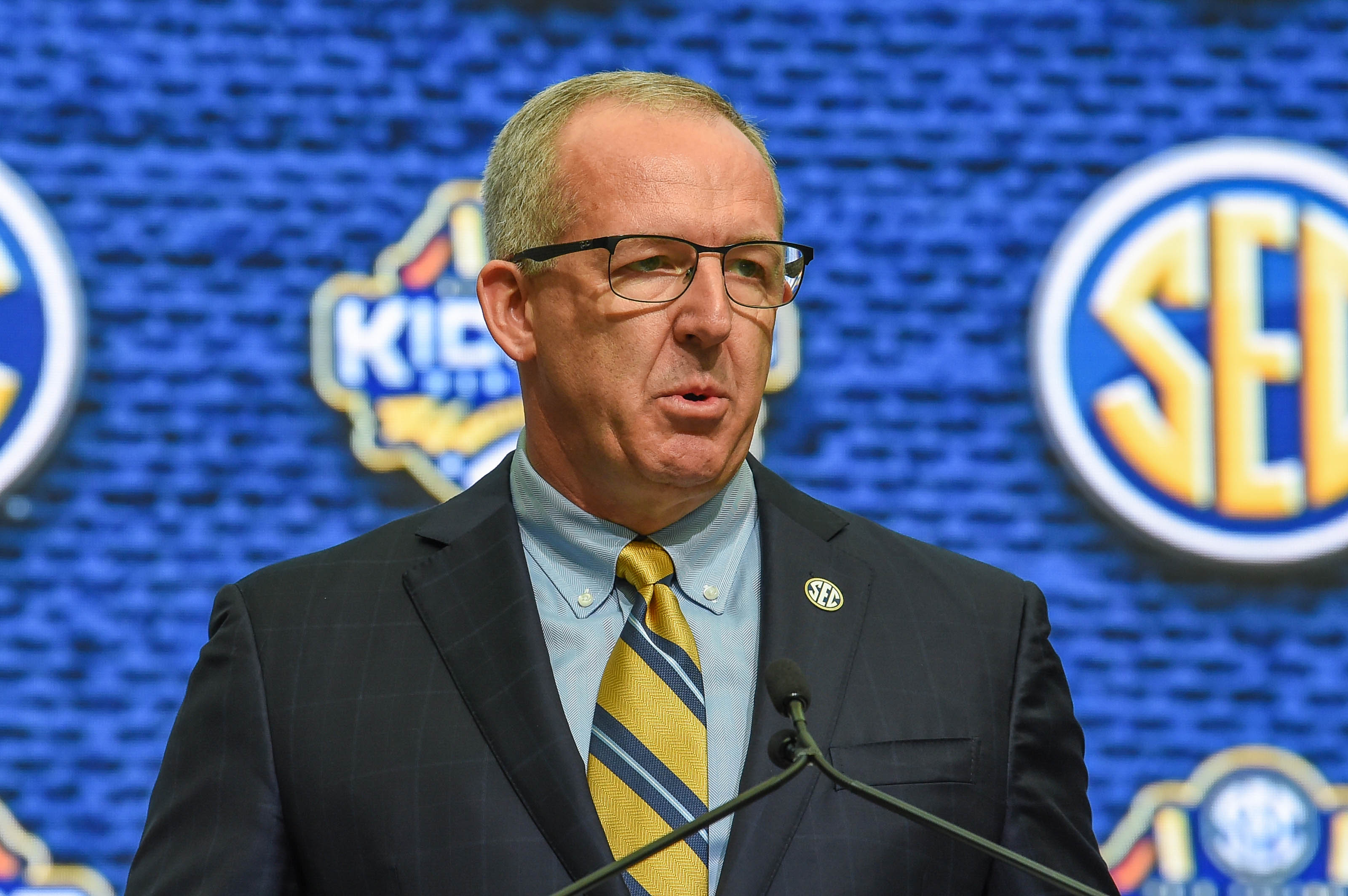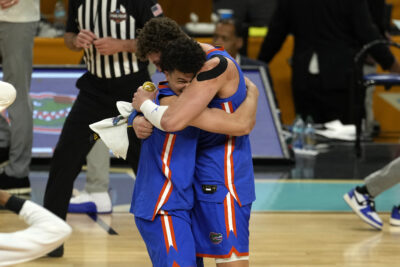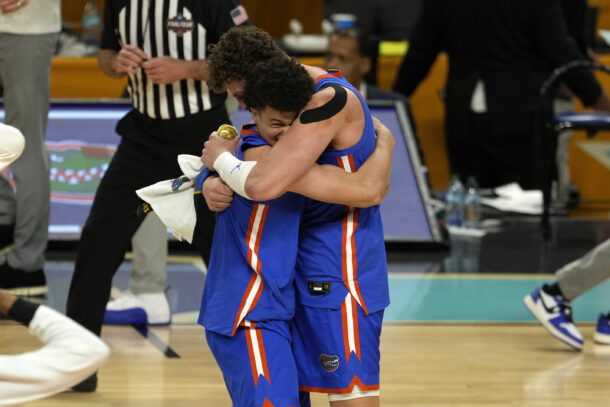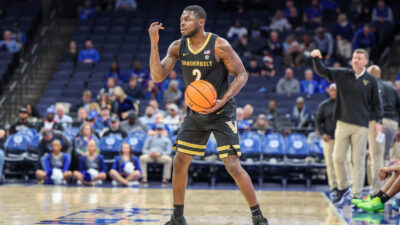
First and 10: How Greg Sankey, Tony Petitti ended the SEC-B1G Cold War … and what comes next for college football
By Matt Hayes
Published:
1. I don’t want to get on a soapbox, but …
Shrouded by the upheaval and uncertainty of the pandemic, the genesis of this unique partnership began in 2020.
So did the mistrust.
“This partnership, or whatever this becomes,” an industry source told Saturday Down South, “doesn’t happen if Kevin Warren is the Big Ten commissioner.”
SEC commissioner Greg Sankey didn’t trust Warren, and because the SEC presidents value Sankey and his leadership, they didn’t trust Warren, either.
There’s no chance a partnership, an inevitable cooperation between college sports heavyweights, happens if Sankey and new Big Ten commissioner Tony Petitti — barely 9 months on the job since replacing Warren, who left for the NFL — didn’t grow to trust each other in such a short time.
Out of ingenuity or necessity, they’re moving forward to find answers to an unsettling future of college sports generally, and college football, specifically.
And leaving the cold war behind.
“There was significant damage there, that’s probably the best way to say it,” an SEC athletic director said of the relationship between the two conferences prior to Petitti’s arrival last April. “When you have no idea what’s coming next, there’s no level of trust.”
Like the summer of 2020, when the commissioners of the then-Power 5 conferences met to chart a course through the pandemic. The overriding philosophy was to allow scientific data and real-time anecdotal evidence — however skewed it now looks, 3 years later — dictate the decisions on playing a 2020 season.
The commissioners met, and began hashing out nonconference schedules between the Power 5 conferences. At that point, there was uncertainty about the ability of Group of 5 schools to afford testing, especially if it meant multiple tests over a week for the entire 85-man roster.
During a conference call of the commissioners, and after the group was making progress, Warren interrupted the call and abruptly pulled out, declaring, “the Big Ten has to lead, and we’re leading right now,” multiple sources told SDS.
The Big Ten’s departure sidetracked everything. Not long after, the Big Ten canceled the season, and the Pac-12 quickly followed because it walks lockstep with the Big Ten on all matters.
Warren then publicly leaked the nonsensical idea of spring football, following an idea put forth by the Ivy League (which eventually didn’t play in the spring of 2021) where schools would play 2 seasons in 9 months.
It was bad enough that, at the time, the NCAA still owned a player’s name, image and likeness — despite looming, game-changing bills passing through the legislatures of California and Florida — and still had the hammer of limiting player movement.
Now Warren was pitching an idea that would ask those same players to compete in 2 seasons over 9 months — all while the NCAA was fighting the players’ ability to earn off their NIL and restricting their movement. The idea was utterly laughable, and more damaging to the relationship between the SEC and Big Ten, showed how disconnected Warren was from an horizon of change that was quickly closing.
Months later, after a near revolt from conference members and after the SEC, ACC and Big 12 were moving forward with the original plan to play, the Big Ten decided to “return to play.” The Pac-12, of course, quickly followed.
“That ended any hope of cooperation moving forward between the two conferences,” an SEC source told SDS.
Then it got worse.
2. The unraveling
The bombshell news arrived in the summer of 2021 — at SEC Media Days, of all places.
Texas and Oklahoma were leaving the Big 12 and joining the SEC.
This monumental shift of conference expansion — two of college football’s biggest properties moving to its most successful conference — was a big problem for the Big Ten. And it led to Warren’s shrewdest move of all.
The Alliance with the Pac-12 and ACC.
The Alliance was formed, more than anything, to prevent the 12-team Playoff — of which Sankey was an integral factor in its development — from moving forward. Because if the expanded Playoff stays on course and is implemented by the 2022 or 2023 season, Warren may not have been able to convince USC and UCLA to leave the Pac-12.
Under the 12-team Playoff structure, Power 5 teams each get about $6 million annually from the Playoff. A team that makes the Playoff gets another $4 million, and another $4 million after that for reaching the quarterfinals.
Teams earn another $6 million paid to their conference by advancing to the semifinals, and another $6 million to their conference by advancing to the championship game.
In other words, USC or UCLA could’ve made the new 12-team Playoff as a member of the Pac-12, and earned $14 million by reaching the quarterfinals. USC and UCLA could’ve also negotiated the final Playoff payments from conference to school distribution — and a desperate Pac-12 would’ve agreed to save the league.
That potential $26 million carrot every season would’ve been hard to ignore for USC and UCLA, especially considering the physical and mental toll of traveling cross-country for their student-athletes by joining the Big Ten.
But Warren cobbled together the “Alliance” and scuttled the 12-team Playoff by with the help of the Pac-12 and ACC, and with postseason uncertainty looming — and the overall structure of the sport teetering — he was able to pry USC and UCLA from the Pac-12.
Think about that concept: forming an Alliance of “like minds” — complete with an us against the world press conference — all while setting in motion the wheels to stab an Alliance “partner” in the back less than a year later.
At this point, it may as well have been Eisenhower vs. Khrushchev. The Cold War was alive and well in college football.
Then the NFL’s Bears stepped in and offered a lifeboat, hiring Warren as their team president.
Now in the midst of all that is unfolding in college sports, the uncertainty of NIL and free player movement and eventually revenue sharing, Sankey and Petitti realize the only way out is through cooperation. And trust.
3. Moving forward
The overriding question: What does the new world look like?
What steps do the SEC and Big Ten take to move away from an “amateur model” held so dearly by so many within the NCAA structure, and find a solution that may not be good for all — but good for enough?
The Playoff. NIL. Player movement. Roster management. Rules enforcement. And the big one: revenue sharing.
Everything is on the table, and no idea too large or too unthinkable. It’s Sankey’s “blue skies” philosophy all over again: in a perfect world, what does it look like?
The last time Sankey delivered his “blue skies” speech, it was in response to the 12-team Playoff being indefinitely shelved by a vote from the “Alliance.” Everything was on the table then, too — including the SEC holding its own Playoff.
This time around, Playoff expansion is possible (to as many as 16 teams), beginning in the 2026 season — when the new contract begins. So is the structure of the Playoff (the SEC and Big Ten want all at-large bids), and how campus games and bowl games are implemented.
But the larger issue is player movement, because it encompasses nearly every key move on the board: NIL, roster management, recruiting and enforcement. And it all potentially falls under the umbrella of revenue sharing.
If revenue sharing is implemented — no matter what it looks like or the amount shared — it will come with roster control stipulations (see: contracts).
That also likely means collective bargaining. How it looks, and how it is structured will come in the near future.
But by moving forward as 2 conferences — not 10 conferences — the process of change in all areas is streamlined and avoids constant bureaucratic red tape (the NCAA, and the remaining conferences).
Or as one industry source told SDS, “There will be a moment down the road where they say, ‘This is where we are, this is the structure, this is what we’re doing. If you want to be part of it, get on board.’”
4. Rare change, The Epilogue
No one is publicly stating as much, but there’s little doubt where this could be headed: a full breakaway of those who can from those who can’t.
Those who can afford to share revenue, and those who can’t. Those who can, join the group.
Those who can’t likely become another level of Division I football, continuing under the NCAA umbrella.
Is it just football, or is all sports? Is it just football and the Playoff, or is it all postseason, including their own men’s and women’s basketball tournaments?
These are the paradigm questions still to be answered, and part of an ever-shifting landscape that includes Florida State’s legal arguments to leave the ACC — and the fallout of a successful court case opening the door for other ACC defections.
“They are all one in the same,” another SEC athletic director said. “Every issue that must be dealt with, in one way or another, is part and parcel of the others.”
5. The Weekly 5
The top 5 Day 2 or 3 SEC prospects in the NFL Draft.
1. DE Darius Robinson, Missouri
2. QB Spencer Rattler, South Carolina
3. RB Ray Davis, Kentucky
4. Edge Chris Braswell, Alabama
5. CB Nehemiah Pritchett, Auburn
6. Your tape is your resume
An NFL scout analyzes a draft-eligible SEC player. This week: Arkansas C Beaux Limmer.
“He held his own at the Senior Bowl. I like his grit and toughness. He plays a little too high, and has a tendency to be susceptible to bull rushes. There’s too much being made about one rep against (T’Vondre Sweat), who has 40-50 pounds on (Limmer). That’s social media. You’re not seeing the other reps where Limmer was aggressive and strong at the point of attack. Look, he’s far from a finished product, and he needs some bulk. High football IQ, and a guy that, in the right system, can be a starter early.”
7. Powered Up
This week’s Power Poll, and 1 big thing: Top NFL Draft prospect for 2024.
1. Georgia: TE Brock Bowers. He’s all over the board in the 1st round, and projected as high as top 7 in some drafts. Look at the tight ends of the final 4 teams in the NFL playoffs: Travis Kelce, George Kittle, Mark Andrews and Sam LaPorta — all superstars, or on the verge.
2. Texas: DT Byron Murphy II. Sweat received all the hype in 2023, and Murphy was the better player. Sweat is a true 1 technique for odd fronts, and Murphy is a 3 technique for even fronts. He’s a not an odd front over the nose player.
3. Ole Miss: Edge Cedric Johnson. He’s undersized as a true end in an even front. His best fit is a odd front, outside linebacker/edge.
4. Alabama: CB Terrion Arnold. Some scouts prefer Kool-Aid McKinstry. Arnold is more consistent, has strong hands and is a physical presence in the run game (not that McKinstry isn’t).
5. Missouri: CB Ennis Rakestraw Jr. Much like the Arnold/McKinstry debate, there are some scouts who prefer Kris Abrams-Draine. Rakestraw is bigger and longer, and may be the best in the draft in mirroring coverage.
6. LSU: WR Malik Nabers. Long-term, Jayden Daniels will be the answer. But short-term, with his speed, explosiveness out of cuts. and big frame, Nabers is the choice,
7. Oklahoma: OT Tyler Guyton. A long, massive pass protector with a high ceiling. Has only played 1 full season as a starter, but the potential is there.
8. Tennessee: CB Kamal Hadden. Not as publicized as other corners in the SEC, but had just as good a season. A shoulder injury 7 games into 2023 derailed what should’ve been a breakout season.
9. Texas A&M: S Demani Richardson. Looks and plays a lot like Antonio Johnson, who was selected in the late rounds in 2023 by the Jaguars. Can play slot corner and cover tight ends if needed.
10. Kentucky: CB Andru Phillips. An athletic, rangy player with terrific closing speed. Only 5-10, but still as good length.
11. Auburn: CB DJ James. Nehemiah Pritchett probably has the higher upside because of his speed, but James is technically sound and physical. A tough, smart player.
12. Florida: WR Ricky Pearsall. Deceptively quick and tough, he’ll thrive in the right system in the slot. He’s not winning consistently on the outside, but can cause problems in the slot.
13. South Carolina: WR Xavier Legette. It’s hard to ignore 1 season of productivity in 5. It’s also hard to ignore how dominant Legette was, despite South Carolina’s problems with pass protection and QB Spencer Rattler’s struggles because of it.
14. Arkansas: C Beaux Limmer. Many scouts believe Limmer is an early Day 3 pick, but he has the potential to develop into a starter.
15. Mississippi State: LB Nathaniel Watson. He’s not going to win a 40-yard dash contest, but he’ll win his share of football battles. Was impressive for much of the week during individual and team drills at the Senior Bowl. His 40 time — not his production — will be the issue.
16. Vanderbilt: Matthew Hayball is likely an undrafted free agent, but there’s always opportunity for punters in training camp — especially one who averaged 47.6 yards per punt in 2023.
8. Ask and you shall receive
Matt: Now that we see the SEC and Big Ten teaming up to steal college football from the rest of us, who will be the fortunate souls added to the elite clubs? — Jenn Vulen, Scottsdale, Ariz.
Jenn:
The obvious first choice would be Notre Dame, but the Irish have the money and the commitment to stay independent. The only way that changes is if access to the Playoff changes. And I don’t see that happening.
Notre Dame will, like everyone else, have a chance to earn an at-large bid. There will be no automatic bid for Notre Dame now, or with whatever the future postseason looks like.
As for the rest, it all depends on how far the SEC and Big Ten are willing to take it. Does it become a members-only club of those who can afford to share revenue with players? If so, is it a version of the NFL with 2 conferences?
Much of this also depends on FSU’s ability to break the ACC’s Grant of Rights deal. If the Noles do so, the ACC picked over — with its best (most profitable) properties potentially absorbed by the SEC, Big Ten and Big 12.
In a perfect world the SEC/Big Ten get what they want: complete autonomy (including enforcement), a postseason Playoff structure to their liking, and the ability to control player movement through shared revenue at some point in the future (when it’s no longer viable to fight it in court).
9. Numbers
4.84. Among the many deficiencies of the Florida defense in 2023: stopping the run.
The Gators gave up a whopping 4.84 yards per carry, the highest number since before Steve Spurrier returned to his alma mater in 1990.
10. Quote to note
Auburn coach Hugh Freeze on his quarterbacks: “I really like our room. I wanted to try to build with high school kids like Hank (Brown) and Walker (White), and us try to develop those guys along with, obviously, the experience Payton (Thorne) brings. I kinda wanna see that through.”
Matt Hayes is a national college football writer for Saturday Down South. You can hear him daily from 12-3 p.m. on 1010XL in Jacksonville. Follow on Twitter @MattHayesCFB






